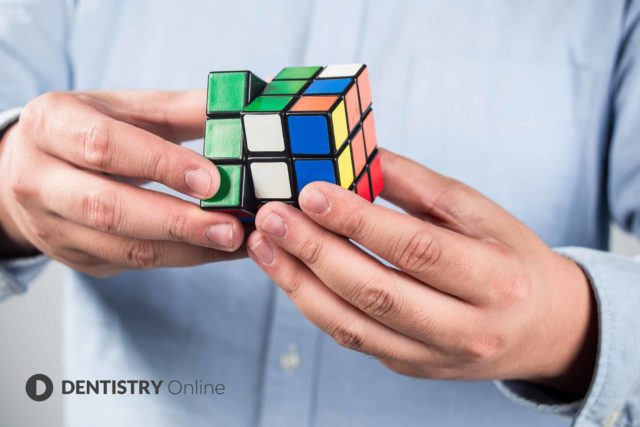 Diyari Abdah discusses some very common implant problems and presents some ways to avoid them.
Diyari Abdah discusses some very common implant problems and presents some ways to avoid them.
It is not the purpose of this series to deal with all implant problems. However, it is worth mentioning some of the very common problems, which this article will focus on.
Not placing the right number or size of implants
Failure to respect occlusal considerations, combined with too few implants to take a large occlusal load, can lead to failure.
This can happen very quickly. Many enquiries come from unhappy patients who have spent a lot of time and money thinking that they had a solution to their problem, and yet find out that everything failed.
Of course, with that goes the trust in the initial dentist who delivered the treatment.
Common sense dictates that we start the entire treatment planning process with the end result in mind.
This is why study models, correct radiographs/CT scans, three-dimensional modelling, diagnostic wax-ups and occlusal analysis. All these elements are important factors here.
Think where the occlusal forces might be highest and plan what you need in those areas to support the restoration(s). Then, based on the available bone and anatomical structures, you can plan your implant case with or without grafting where needed.
Communicating with the patient
We should never compromise the positioning of an implant. We don’t want to (or don’t have the right skills) to carry out a grafting procedure (to enhance the bone/soft tissue profile), or because the patient refused a graft.
Unfortunately, sometimes this happens as the dentist tries to be ‘accommodating’ to the patient’s requirements. That’s like a pilot flying according to the passenger’s technical requirements.
The way that the dental professional presents information to the patient holds great importance.
When the right procedure has to be done for the right reason, an executive decision has to be made to thoroughly explain to the patient, giving them all the necessary information about why we have to do what we have to do. If this is done satisfactorily, then most patients will put up very little resistance.
Remember, they trust you and that’s why they are there in the first place.
Paying attention
While on the subject of occlusion and its importance in implant dentistry, one major problem could be not paying attention to the lateral forces when restoring implants. This is fatal for the implants in the long run.
This is not just an issue for the restorative dentist, but also for the surgeon who places the implants. The surgeon often gives little room for the restorative dentist to manoeuvre and restore correctly.
One example is when the implant is placed at an angle because of the bone but, because of this, the restoration has to be less than ideal and subsequently will fail when in use after sometime.
Good communication between the surgeon and the restoring dentist, together with the laboratory technician, is of utmost importance for the overall success of every case.
In planning any case, we must always be mindful of the need to maintain a favourable occlusal scheme if it is to be a long-term success.
The starting point is a correctly fabricated wax-up (or a digital scan), which takes into consideration the correct occlusal table for the restoration – without any sharp or high cusps – and minimises the negative effects of lateral/excursive movements on the implant.
Occlusal biomechanical stress
Creating correct vertical dimension is critical, together with correct angulation of the implants and the restorations, to minimise bending moments on the components.
For dentures, a customised occlusion is adapted and tested to improve the long-term prognosis of the implant-denture interface.
If implants and natural teeth are part of a functioning dental arch, the natural teeth should meet the opposing dentition prior to the implants. Remember that a foreign structure (like implants) in bone react differently to forces than natural teeth do.
In conclusion, occlusal biomechanical stress (forces) is a critical factor in the long-term prognosis of any implant case. The higher the number of implants that have to be placed, the more mindful of their correct positioning and alignment we have to be.
Over the years, many placement sequences and positioning have been suggested. This was to avoid unwanted torque forces, thus distributing the forces in a favourable way.
Among these suggestions is to always use the longest and widest implants (when possible) in a non-linear way, but not too close to each other, that can be favourably restored in a functional and aesthetical manner.
Although more research has recently been done on shorter implants (and some literature encourages their use when there is insufficient bone height), they are still under scrutiny by some, and more research is needed in this area before we can give up on traditional sinus and vertical ridge augmentations.
In certain cases of restoring the posterior maxilla with shorter implants, it would have been easier to perform a sinus augmentation and subsequent long implant than a very short implant initially with subsequent thread exposure problems.
Remember, the exposure of only two to three threads of a very short implant results in 50% or more bone loss around that implant!
Careful observation
It is critical to observe and note the bone contour prior to surgery. Ideally through a CBCT scan and 3D modelling of the jaw.
Although some clinicians use CBCT scans for almost every case, the majority of surgeons still try to get a feel for the buccal bone contour through observation. Also, simple palpation and possible ridge mapping, especially in cases of one or two implants.
Being equipped with the right knowledge in dealing with these defects makes a difference in making the case a success.
Preoperative wax-ups can indicate the ideal positioning of implants and indicate the need for any bone augmentation, but CBCT scans and 3D digital models can demonstrate this even more accurately.
It is important to note that it is more predictable to place an implant in the native bone, despite its uneven topography (provided the quality and quantity of the bone is good) than in a block graft that may resorb because of a disturbed blood supply.
Bone resorption can happen after an extraction (before placing an implant) as part of socket remodelling. Alternatively, it can happen after the implant has been placed and is in function.
Both require much attention but the treatment approach can be different.
Avoiding resorption after extraction can be achieved by applying one of the many socket preservation techniques in the literature. This can be done easily; there is little excuse for resorption to occur.
Dealing with bone dehiscence and alveolar bone irregularities
Planning and sequencing implant placement after extraction can also reduce the incidence of post-extraction bone resorption. This too has been documented extensively in the literature.
Dealing with bone dehiscence after placement is another issue. The principles are the same but the approach is different.
If the cause is infection, the aetiology has to be identified and treated accordingly to prevent further bone loss. If the cause is parafuncion and no infection is involved, then the implant surface has to be cleaned. A HA graft is applied to aid soft tissue adherence. The source of the parafuncion eliminated.
Performing a ridge splitting procedure and/or block grafts can enhance the overall thickness. Especially in the case of a very thin ridge. However, the easiest way can sometimes be flattening the edge of the ridge to gain a platform for the implant placement – height permitting.
Apical bone perforations (fenestration) can also be noted sometimes in the maxilla. These require bone grafting, sometimes combined with guided bone regeneration.
Conclusion
Treating our patients with dental implants can be very rewarding, but it should not be taken lightly. Implant dentistry combines many disciplines and just one mistake can have negative consequences later.
Using all the diagnostic tools available to us is the best way to avoid mishaps and achieve the desired results.
Above all, be curious and critical. Learn everything you can from others and your own cases. Be prepared to change things when they don’t work.
This article first appeared in Implant Dentistry Today magazine. You can read the full issue here.
Follow Dentistry Online on Instagram to keep up with all the latest dental news and trends.
Let’s block ads! (Why?)






